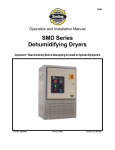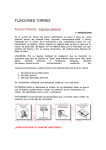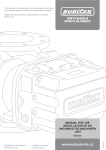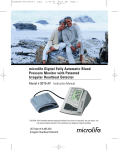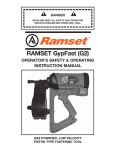Download RAMSET D60 Operating instructions
Transcript
DANGER THIS TOOL FOR USE BY LICENSED OPERATORS ONLY. READ AND OBEY ALL SAFETY AND OPERATING INSTRUCTIONS BEFORE OPERATING TOOL. RAMSET D60 TOOL OPERATOR’S SAFETY & OPERATING INSTRUCTION MANUAL SEMI-AUTOMATIC, LOW VELOCITY PISTON TYPE FASTENING TOOL SAFETY INTRODUCTION DANGER DANGER THIS TOOL IS TO BE USED ONLY BY PROPERLY TRAINED AND LICENSED OPERATORS. YOU MUST SUCCESSFULLY COMPLETE THE RAMSET TRAINING PROGRAM FOR THE TOOL AND OBTAIN A CERTIFIED OPERATOR’S LICENSE BEFORE HANDLING, LOADING OR OPERATING THIS TOOL. ATTEMPTING TO HANDLE OR OPERATE THIS TOOL WITHOUT PROPER TRAINING AND LICENSING CAN RESULT IN SERIOUS INJURY TO THE OPERATOR OR BYSTANDERS. Operator’s and bystanders must wear eye and hearing protection. Read manual before operating tool. Never close tool with hand over fastener loading end of the tool. A serious hand injury from penetration by the piston or a discharged fastener could result. DANGER Just as no one can merely read a book about driving an automobile and then hope to drive one safely, no one should attempt to use any Ramset tool without adequate, competent personal instruction. And just as one must be licensed to drive an automobile, one must also be licensed to use a powder actuated tool. No automobile instruction book or instructor can forewarn a learner against all possibilities and emergencies, nor can Ramset instructors and printed material detail all possible conditions surrounding the use of Ramset tools and products. Responsibility for the safe and proper use of this tool rests with the tool user and the employer. SAFETY INTRODUCTION 2 DANGER DANGER SAFETY INSTRUCTIONS Preparation Acceptable Base Materials Powder actuated fastening is suitable for use in the following base materials only: • Poured Concrete • Structural Steel • Masonry Joints (see page 8) Never attempt to fasten into any other type of material. Fastening into other materials can cause blindness or other serious injury. NEVER FASTEN INTO VERY HARD OR BRITTLE MATERIALS Unacceptable Base Materials Never attempt to fasten into very hard or brittle materials such as cast iron, tile, glass, or rock of any type. These materials can shatter, causing the fastener and/ or base material fragments to fly free and cause serious injury to the tool operator and others. Never fasten into soft base materials, such as drywall or lumber products. These materials may allow the fastener to travel completely through and out the other side, endangering those in the path of the fastener. Never fasten into any base material that does not pass the Center Punch test. Failure to assure the suitability of the base material can result in serious injury to the eyes or other body parts. Center Punch Test ALWAYS WEAR SAFETY GOGGLES WHEN PERFORMING THIS TEST. 1. Always check the material being fastened into for hardness before attempting any fastening operation. NEVER FASTEN INTO SOFT MATERIALS SUCH AS DRYWALL Center Punch Test Results 1. If the fastener point is flattened, the material is too hard for a powder actuated fastening. 2. If the fastener penetrates the material easily, the material is too soft. 3.If the material cracks or shatters, the material is too brittle. 4. If the fastener makes a small indentation into the material, the material is suitable for fastening. 2. Using a fastener as a center punch, strike the fastener against the work surface using an average hammer blow and check the results. DANGER SAFETY INSTRUCTIONS 3 SAFETY INSTRUCTIONS DANGER Loads & Load Selection Safety 1.Always make a test fastening after being sure that the base material is suitable for powder actuated fastening. Failure to determine the correct power level to be used may result in the use of excessive power, allowing the fastener to pass completely through the work material, causing serious or fatal injuries to others who may be in the path of the fastener. ALWAYS MAKE A TEST FASTENING 2. Color-blind operators must always select disc loads by number to prevent use of an incorrect load for the same reasons as in 1 above. Workplace Safety 1. Operators and bystanders must always wear approved eye protection and approved hearing protection. Failure to do so may result in blindness or serious eye injury from flying debris and loss of hearing from constant or repeated unprotected exposure to fastening noise. 2. Always keep the work area clear of bystanders and unnecessary materials that could interfere with safe tool operation. Operating the tool in a congested or cluttered area may affect your ability to operate the tool safely. 3. Never operate tool if flammable or explosive materials are nearby. Powder loads burn and create sparks when fired and could ignite these materials or fumes. 4. Always post warning signs within 50 ft. of the area where fastening is to be done. Sign must state: “WARNING - Powder Actuated Tool In Use”. Failure to warn others may result in serious injury to them. Contact Ramset at 1-800-241-5640 to obtain this sign. COLOR-BLIND OPERATORS MUST ALWAYS SELECT LOADS BY NUMBER KEEP WORK AREA CLEAR OF BYSTANDERS AND CLUTTER NEVER OPERATE THE TOOL AROUND FLAMMABLE OR EXPLOSIVE MATERIALS WARNING POWDER ACTUATED TOOL IN USE WITHIN 50 FEET Safety is important – Take proper precautions. ALWAYS POST WARNING SIGNS SAFETY INSTRUCTIONS 4 DANGER DANGER SAFETY INSTRUCTIONS Tool Handling Safety 1. Always be sure tool is operating properly before attempting to use it. Follow the “Daily Function Check” shown to the right and described on page 9. 2.Always load tool using a disc load selected directly from a box indicating the power load type and number. Never attempt to use loose disc loads that could be mis-identified. 3. Never carry loose disc loads in pockets with pins or other hard objects. Empty B A C D 1 2 ALWAYS DO A DAILY FUNCTION CHECK BEFORE LOADING TOOL 4. Never load a tool unless you intend to immediately make a fastening. Loading a tool and leaving it unattended in the work area can result in the tool being accidentally discharged by others. 5. N ever place your hand or any other body part over the fastener loading end of the tool. Serious hand injury could result from being struck by either a fastener or the tool piston should the tool be accidentally fired. NEVER LOAD THE TOOL UNLESS IT IS TO BE USED IMMEDIATELY 6. A lways store the tool unloaded and keep the tool and the loads securely locked in a tool box. Keep keys away from children and unlicensed persons. 7. A lways keep the tool pointed away from yourself and others. 8. N ever carry a loaded tool around the work area. NEVER PLACE HANDS OR BODY OVER MUZZLE OPENING 9. N ever allow anyone not trained to use the tool. 10. N ever engage in horseplay with the tool. 11. U sing the tool in poorly ventilated areas, cleaning tool or handling loads may result in exposure to lead or other substances known to cause birth defects, and other physical harm. Have adequate ventilation at all times and wash thoroughly after exposure. DANGER KEEP TOOL LOCKED & OUT OF THE REACH OF CHILDREN SAFETY INSTRUCTIONS 5 DANGER SAFETY INSTRUCTIONS FAILURE TO FOLLOW INSTRUCTIONS CAN CAUSE INJURY TO THE TOOL OPERATOR OR TO BYSTANDERS. Fastener Driving Safety 1. Only use the tool for fastening into a suitable base material. 2. Never fire the tool without a fastener. Firing a tool without a fastener will cause the piston to strike the work surface, and may cause serious injury to you and others in the work area. SPALL GUARD USE THE SPALL GUARD WHENEVER POSSIBLE 90° 3. Always use the spall guard whenever possible to minimize flying particles or debris. 4.Always hold the tool perpendicular to and firmly against the work surface when making a fastening. Failure to do so could allow a fastener to ricochet. ALWAYS HOLD THE TOOL PERPENDICULAR TO THE WORK SURFACE 5. Never attempt to drive a fastener close to an edge or to another fastener. See page 8 for guidelines. ALWAYS FOLLOW THE MISFIRE PROCEDURE. If the tool does not fire after pulling the trigger, continue to hold the depressed tool against the work surface for at least 30 seconds. Then carefully open the tool, remove the load disc, and put it in a can of water or other non-flammable liquid. Never carelessly discard a disc with live loads into a trash container. If the tool becomes stuck or jammed with a live powder load, keep the tool pointed in a safe direction, and immediately tag it, “Danger- defective - do not use”. Lock the tool in a tool box and call your local Ramset distributor for assistance. SAFETY INSTRUCTIONS 6 NEVER DRIVE A FASTENER CLOSE TO AN EDGE HOLD THE TOOL FIRMLY AGAINST THE WORK SURFACE FOR AT LEAST 30 SECONDS DANGER FASTENERS / LOADS Your Ramset D60 Tool uses only the Ramset fasteners and loads shown below or listed for the tool in the Product Catalog. DANGER Never use any other types of fasteners or strip loads in the Ramset D60 Tool. Use of other types of fasteners or loads may cause unintentional load discharge, damage the tool, cause poor fastening performance, or create a risk of serious injury to the operator or bystanders. FASTENERS .300 HEAD PLASTIC FLUTED DRIVE PINS .145 Shank Diameter in Shank Lengths from 1/2” to 2” .300 HEAD PLASTIC FLUTED DRIVE PINS WITH 7/8” WASHER .145 Shank Diameter in Shank Lengths from 1” to 2-1/2” 1/4” - 20 THREADED STUDS .300 HEAD POWER POINT PLASTIC FLUTED DRIVE PINS .145 Shank Diameter in Shank Lengths of 1/2” and 1” and Thread Lengths of 1/2”, 3/4” and 1” .150 Straight Shank in Shank Lengths from 1/2” to 7/8” .150 /.180 Step Shank in Lengths from 1” to 1-7/8” CONDUIT CLIP ASSEMBLIES CEILING CLIP ASSEMBLIES For 1/2” and 3/4” Diameter Conduit with 1” Premounted Fastener Ceiling Clip with 1” or 1-1/4” premounted .145 Shank Pin and Ceiling Clip with 1” or 1-1/4” Premounted .150/.180 Shank Pin LOADS Ramset disc loads are specially made for use in the Ramset D60 Tool. D60/45 DISC LOAD POWER CATALOG LOAD CASE LEVEL NUMBER COLOR COLOR 2 2D60 Brown Brass 3 3D60 Green Brass 4 4D60 Yellow Brass The power level of the load is indicated by the number marked on each box, the color of the box, and the color on the tip of each load. As the number increases, the power level also increases. Always perform the center punch test described on page 3 to test the base material. Always make a test fastening using the lowest power level first. If more power is required to set the fastener, use the next higher power level until the powder level necessary to drive the fastener is reached. FASTENERS / LOADS 7 FASTENING APPLICATIONS FASTENING APPLICATIONS Your Ramset tool can be used for a wide range of fastening needs in a variety of base materials. Reading and following theseimportant fastening guidelines will help you get the best results from your tool, fasteners, and powder loads, as well as help you perform these fastening operations safely and effectively. Powder actuated fastenings are permanent fastening so attempting to remove a fastener from concrete or steel may result in serious injury. Driving fasteners too close to an edge or too close to each other can cause the concrete edge to fail or fasteners to fly free. 3" MIN. Fastening to Steel Your Ramset tool can be used for fastening on the flat surfaces of structural steel. When fastening into steel, always maintain a minimum spacing of 1-1/2” between fastenings and 1/2” from any edge. FASTENING APPLICATIONS 8 3" MIN. SPACING WOOD TO CONCRETE 3" 3" 3" 3" MIN. MIN. MIN. MIN. PENETRATION — THIN GAUGE METAL TO CONCRETE 3" MIN. MIN. 3" 3" MIN. 3" MIN. Fastening to Concrete Block or to Masonry Walls While this application is not recommended, when used, it is necessary to take care to observe a 3” edge distance to avoid cracking the block and over penetration of the fastener to avoid loss of holding value. Fastening may be made into the horizontal joint but not into the vertical joint. 3" 3" MIN. MIN. 3" 3" MIN. MIN. Fastening to Concrete When fastening into concrete, always maintain a minimum spacing of 3” between fastenings and 3” from any free edge. Concrete thickness should be at least three times the intended penetration depth into the concrete. The primary exception to the 3” edge distance can occur in a sill plate application where, by necessity, the edge distance is reduced. 3" MIN. 3" MIN. SPACING — FURRING STRIP TO CONCRETE 1/2" MIN. 1/2" MIN. 1/2" 1/2" MIN. MIN. 1-1/2" MIN. 1-1/2" MIN. 1-1/2" 1-1/2" MIN. MIN. SPACING — STEEL TO STEEL TOOL OPERATING INSTRUCTIONS TOOL OPERATION Daily Function Test Always check the tool first to make sure that it does not contain a disc load or fastener. Test the tool several times by depressing the muzzle bushing fully on a hard surface and pulling the trigger. You should hear an audible click as the firing pin releases. Let up on the tool and check to be sure the barrel has opened to the semi-closed position. PERFORM FUNCTION TEST WITH EMPTY, UNLOADED TOOL OPERATING THE D60 TOOL 1.After checking to be sure that the tool is not loaded, point it in a safe direction and be sure that the barrel is fully extended. This assures that the piston is in position for the next fastening. Use the spall guard every time possible to minimize the risk of being struck by flying debris. OPEN BARREL TO THE FULL OPEN POSITION 2. Slide the barrel to the semi-closed position. NEVER place your hand, fingers or any other part of your body over the muzzle (fastener loading end) of the tool. 3. With finger off the trigger, place the fastener, point out, into the muzzle end of the tool until the point end is inside the muzzle. NEVER load a fastener with your finger on the trigger. DO NOT use excessive force when inserting a fastener. STOP immediately if excessive force is required, inspect the barrel to find out why the fastener is not entering the muzzle freely. DO NOT continue loading unless the problem is corrected. Keep hand away from muzzle. CLOSE BARREL TO THE SEMI-CLOSED POSITION INSERT FASTENER INTO THE MUZZLE END OF THE TOOL WITH THE POINT OUT TOOL OPERATING INSTRUCTIONS 9 TOOL OPERATING INSTRUCTIONS 4. With the tool barrel closed to the semiclosed position and finger away from the trigger, open the cover by pressing the side button, and insert a load disc into the slots in the receiver housing. 5. Close the cover and be sure it is locked. NEVER attempt to make a fastening with the tool cover in the open or unlocked position. 6.Hold the tool perpendicular (90°) to the work surface with both hands and press firmly to fully depress the tool. Maintain firm downward pressure on the tool with both hands and pull the trigger to drive the fastener. DO NOT DEPRESS THE TOOL AGAINST ANYTHING OTHER THAN THE INTENDED WORK SURFACE. Holding the tool firmly in place will produce more consistent fastening quality and minimize tool wear or damage. INSERT LOAD DISC INTO THE SLOTS IN THE RECEIVER 90° HOLD TOOL FIRMLY AND PERPENDICULAR TO WORK SURFACE 7.After making the fastening, with the “tool pointed in a safe direction, pull “the barrel fully open. This resets the piston for the next fastening. Always keep fingers and other body parts away from the muzzle end of the tool. 8.Insert another fastener in the muzzle end of the tool as before and the tool is ready for the next fastening. Keep your finger off of the trigger until the tool is in position to drive the fastener. OPEN AND CLOSE THE BARREL AND INSERT THE NEXT FASTENER 9. To remove a used or partially used load disc from the tool, open the cover and lift out the load disc. NEVER try to remove a jammed or stuck load disc. Should a “jammed” load disc occur, call your local Authorized Ramset Distributor for technical assistance. REMOVE THE LOAD DISC TOOL OPERATING INSTRUCTIONS 10 TOOL OPERATING INSTRUCTIONS D60 POWER LEVEL ADJUSTMENT The power level of the D60 tool may be adjusted for varying materials by changing the length of the barrel. Extending the barrel length reduces the driving power and shortening the length increases the driving power. The D60 tool utilizes a “quick release” pawl design to easily change power levels. QUICK RELEASE PAWL 1. To change the power level, pull the plastic cap on the pawl rearward and twist it 1/4 turn to lock the pawl in the released position. 2. Pull the barrel out until the load chamber assembly ball bearing retainer is visible in the slot in the rear of the receiver. Note the position of the rings on the rear barrel. When the power adjustment feature is not being used, the barrel should be screwed all the way in. 3. Adjust the length of the barrel for the power level required by screwing the barrel either in or out. To increase driving power screw the barrel in and to decrease driving power screw the barrel outward. Do not unscrew the barrel out past the outer power level ring. 4. When using the power adjustment feature with the 4D60 power level load, the power adjustment must be at the lowest power level for initial testing to determine the power level needed for best fastening quality. Ball Bearing Retainer PULL THE BARREL FORWARD Power Level Rings ADJUST POWER LEVEL USING THE RING POSITION 5. Push the barrel back in after adjusting and secure the pawl by pulling the plastic cap and turning it 1/4 turn and then realese it. Always make a test fastening using the lowest power level first. If more power is required to set the fastener, use the next higher power level until the powder level necessary to drive the fastener is reached. PUSH BARREL ASSEMBLY IN AND SECURE THE PAWL TOOL OPERATING INSTRUCTIONS 11 MAINTENANCE MAINTENANCE IMPROPERLY MAINTAINED TOOLS CAN CAUSE SERIOUS INJURIES TO TOOL OPERATOR AND BYSTANDERS CLEAN TOOL DAILY Always make sure the tool is not loaded before performing any service or repair and always wear safety goggles when cleaning or servicing the tool. NORMAL CLEANING All front end parts shown in the disassembly section are to be cleaned daily with a good detergent oil and wire brush. Remove all dirt and carbon buildup and wipe parts dry with a clean rag. Check all parts for wear or damage before reassembly and replace or repair any worn or damaged parts. COMPLETE CLEANING / GENERAL MAINTENANCE Heavy use or constant exposure to dirt and debris may require that the tool be cleaned more extensively. Complete disassembly and cleaning of all parts may be necessary to restore the tool to normal operation. General maintenance should be performed every six months or more often if the tool is subjected to heavy use. Contact your authorized Ramset Distributor for assistance. ALWAYS FUNCTION TEST THE TOOL AFTER PERFORMING ANY SERVICE. SEE PAGE 9 FOR DETAILS ON THE FUNCTION TEST. MAINTENANCE 12 TROUBLESHOOTING REFER TO PARTS SCHEMATIC FOR PROPER ASSEMBLY OF PARTS – Overdriving of fasteners – Excessive power – Change to the next lower power level load disc color and number. – Soft base material – Check base material (see page 3) – Tool fails to fire – Failure to depress – See “Tool does not completely completely depress” – Excessive dirt buildup on – After following misfire breech face not allowing procedure, check firing proper penetration of pin indentation on load. firing pin Clean breech face – Firing pin and/or breech damaged – Replace damaged parts – Tool does not completely – Misassembled or – Check all parts in the depress damaged parts receiver for damage or improper assembly. – Reduction or loss of power – Piston not being returned – Barrel must be pulled to the full rear position completely opened to properly reset the piston. – Worn or damaged – Replace worn or piston or piston ring damaged parts – Worn or broken pawls – Replace pawl – Tool cannot be cocked or opened – Excessive dirt buildup – Clean tool thoroughly – Damaged or bent piston – Replace piston – Broken or damaged parts – Tag tool with warning “Defective–Do Not Use” Place in a locked container and contact your local Ramset representative for service. – Failure to index load – Disc not inserted in tool – Check load disc. Properly correctly or is damaged dispose of damaged disc. (See page 6) – Damaged indexing – Contact your Ramset mechanism Distributor for assistance. – Failure of tool to stay – Retaining ball missing – Contact your Ramset closed when pointed Distributor for assistance. downward TROUBLESHOOTING 13 PARTS SCHEMATIC PARTS SCHEMATIC 14 PARTS LIST RAMSET D60 TOOL PARTS LIST KEY PART NO. DESCRIPTION 5466405 13500 135010 30663 13504 30691 13505 307920 308870 307890 13515 13517 13509 13518 135220 13510 13516 13513 308490 309280 308860 13521 SPALL GUARD OUTER BARREL SHROUD (FRONT BARREL) OUTER BARREL CLIP (PKG OF 3) STANDARD MUZZLE BUSHING REAR BARREL PISTON ASSEMBLY LOAD CHAMBER ASSEMBLY COCKING SLIDE FIRING PIN PAWL AND SPRING FIRING PIN ASSEMBLY COCKING SLIDE SPRING SEAR ASSEMBLY WITH PIN TRIGGER AND PIN LOAD INDEXING LEVER AND SPRING PAWL ASSEMBLY COVER ASSEMBLY TRIGGER LOCK ASSEMBLY FIRING PIN SPRING LATCH BUTTON ASSEMBLY REAR HANDLE ASSEMBLY REAR HANDLE SCREWS AND NUTS BARREL RETENTION BALL AND RING * 1 2 3 4 5 6 7 8 9 10 11 12 13 14 16 17 18 19 20 21 22 23 * NOT SHOWN PARTS LIST 15 DISASSEMBLY TOOL DISASSEMBLY Shroud Clip 1. Slide the barrel assembly out of the tool until the barrel shroud clip is exposed. SLIDE THE BARREL ASSEMBLY OUT OF THE TOOL TO EXPOSE THE CLIP 2. Unscrew and remove the pawl assembly. Note the position of the notch on the pawl as the pawl is removed. The pawl must be installed at reassembly with the notch in this direction. Notch REMOVE THE PAWL ASSEMBLY 3. Slide the barrel assembly completely out of the tool body. Note the position of the ball bearing retainer with the slot in the top of the receiver for reassembly. SLIDE THE BARREL ASSEMBLY OUT OF THE TOOL BODY 4. Remove the barrel shroud clip using a flat screwdriver or long fastener. Take care when removing to be sure the clip does not fly away when freed from the outer barrel. REMOVE THE BARREL SHROUD CLIP DISASSEMBLY 16 DISASSEMBLY 5. Slide the barrel assembly from the outer barrel shroud and muzzle bushing. 6. Unscrew the firing chamber from the barrel. NOTE: When ready to reassemble the firing chamber, do not screw it on tightly to the barrel so that it can be readily aligned with the slot in the receiver. REMOVE THE BARREL ASSEMBLY FROM THE BARREL SHROUD 7. Remove the piston from the barrel by pulling straight outward. If necessary the piston can be removed by using a rod inserted through the opening in the rear of the barrel. 8. Inspect all parts for wear or damage and clean or replace as required. Use detergent oil and cleaning brush. Wipe parts dry before reassembly. WEAR EYE PROTECTION WHEN CLEANING TOOL PARTS. 9. Check the piston tip for mushrooming or other deformities, and grind flat. The tip of the piston must be 90° to the shank and grinding must only be done by qualified personnel. The overall minimum length of the piston must not be less than 5-13/16”. When less than this length, the piston must be replaced to avoid tool damage. 10.Reassemble the tool in the reverse order of disassembly. ALWAYS PERFORM THE DAILY FUNCTION TEST BEFORE USING THE TOOL AFTER CLEANING OR SERVICING. UNSCREW THE FIRING CHAMBER REMOVE THE PISTON FROM THE BARREL 18° 7/32” 90° GRIND THE PISTON TIP FLAT AND BEVEL THE TIP EDGE AT 18° DISASSEMBLY 17 D60 WARRANTY AND LIMITATIONS Ramset warrants that new D60 power fastening tools, parts and accessories will be free from defects in material and workmanship for the period shown below. THREE-YEAR WARRANTY A three-year warranty will apply to all parts, except those listed below as normal wearing parts, or parts which are specifically covered by an extended warranty. The following parts are considered normal wearing parts and are excluded from the warranty: • Piston • Buffer • Pawls • Piston Rings • Spring Clips The warranty period is based off of tool build date, determined from the tool serial number. Ramset may extend the warranty time frame from the date of purchase with a qualifying document proving date of purchase. WARRANTY STATEMENT Ramset’s sole liability hereunder will be to replace any part or accessory which proves to be defective within the specific time period. Any replacement part or accessory provided in accordance with this warranty will carry a warranty for the balance of the period of warranty applicable to the part it replaces. This warranty does not apply to part replacement required due to normal wear. This warranty is void as to any tool which has been subjected to misuse, abuse, accidental or intentional damage, use with fasteners, and loads not meeting Ramset specification, size, or quality, improperly maintained, repaired with other than genuine D60 replacement parts, damaged in transit or handling, or which, in Ramset’s opinion, has been altered or repaired in a way that affects or detracts from the performance of the tool. Ramset MAKES NO WARRANTY, EXPRESSED OR IMPLIED, RELATING TO MERCHANTABILITY, FITNESS, OR OTHERWISE, EXCEPT AS STATED ABOVE and the liability AS STATED ABOVE AND AS ASSUMED ABOVE is in lieu of all other warranties arising out of, or in connection with, the use and performance of the tool, except to the extent otherwise provided by applicable law. Ramset SHALL IN NO EVENT BE LIABLE FOR ANY DIRECT, INDIRECT, OR CONSEQUENTIAL DAMAGES, INCLUDING, BUT NOT LIMITED TO DAMAGES WHICH MAY ARISE FROM LOSS OF ANTICIPATED PROFITS OR PRODUCTION, SPOILAGE OF MATERIALS, INCREASED COST OF OPERATION OR OTHERWISE. Ramset reserves the right to change specifications, equipment, or designs at any time without notice and without incurring obligation. Copyright 2008 Ramset POWDER ACTUATED TOOL TM MANUFACTURES' INSTITUTE INC. THE MODEL D60 TOOL COMPLIES WITH OSHA REQUIREMENTS AND WITH ANSI A10.3 SPECIFICATIONS FOR TOOL REPAIR SERVICE CONTACT YOUR LOCALAUTHORIZED RAMSET DISTRIBUTOR OR TO FIND YOUR NEAREST RAMSET TOOL REPAIR CENTER VISIT OUR WEB SITE AT WWW.RAMSET.COM OR CALL 800-241-5640 Concrete Fastening Systems Glendale Heights, IL 60139 800-RAMSET6 (1-800-726-7386) www.ramset.com Buy with Confidence... Buy From Your Authorized Distributor AN ILLINOIS TOOL WORKS COMPANY © ILLINOIS TOOL WORKS 2008 PRINTED IN FRANCE REVISED 11/08 Form No. SMD60-11/08
























